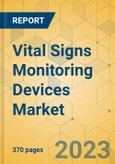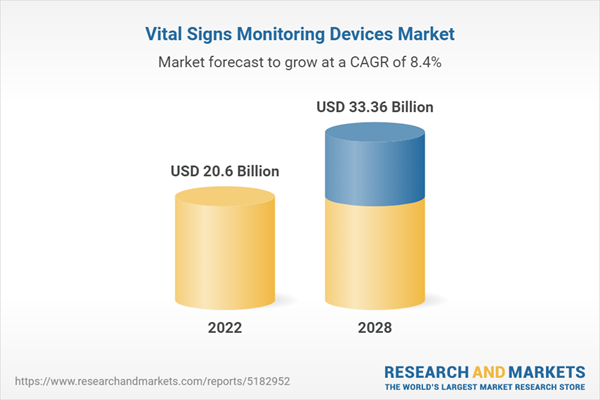Speak directly to the analyst to clarify any post sales queries you may have.
MARKET TRENDS & OPPORTUNITIES
Technology Development in Vital Sign Monitoring Devices
With the advances in technologies in the vital signs monitoring devices market, advanced vital sign devices become more common in various healthcare filed and across daily lives. Whether it is used for prevention or management, such health-associated solutions call for robust and reliable technology. Internet of Things (IoT) is a major factor that penetrated 50% of healthcare in developed and rapidly developing countries, from patient care management to post-care. Recently, the advancement in vital sign monitoring devices, such as the addition of sensors, software integrations, digital screens, and mobile-based applications, resulted in rapid development.Growing Shift Towards Remote Patient Monitoring (RPM)
RPM has enabled medical professionals to observe patients virtually along with vital clinical information and make decisions to improve care outcomes. In these procedures, vital sign monitoring devices accurately deliver clinical data to medical professionals. The increasing demand for remote patient monitoring is accelerating the growth of the vital signs monitoring devices market. Further, remote patient monitoring helps improve quality of life by being cost-effective and reducing the chance of hospitalization. In addition, the older population's preferences for home care settings are accelerating the demand for vital sign monitoring devices.
Enhance Adoption with Patient-centric Digital Systems with Wearable Devices & Telemedicine
In healthcare settings, increasing demand for telemedicine/telehealth is expected to drive remote monitoring. In contrast, accurate monitoring and diagnosis system will be most important to collect vital signs and other data points. Where the increasing shifts towards telemedicine platforms to deliver and receive care, vital sign monitoring devices are playing a vital role. As in healthcare management, multi-sensor and wearable technologies emerge, digital devices integration of electronic health records (EHRs) expects to optimize day-to-day operations and offers data for strategic decision making.Increasing Burden of Chronic Disorders
Globally, healthcare settings are witnessing for increasing burden of chronic disorders. Chronic conditions pose a mental and financial burden. However, the vital signs monitoring devices market has witnessed huge growth and development. The year-on-year increasing patient population with minor to severe chronic conditions drives the significant demand for vital sign monitoring devices because it not only helps to reduce the burden but also offers early indications that reduce the risk of mortality, morbidity, and disability of individuals.Available Integrated Vital Sign Monitoring Devices Offer More Benefits
In healthcare, vital sign monitoring systems are rapidly becoming more popular and core. It shifted the traditional paradigm and manual clinical data recording to computer-based electronic records and handheld devices as innovative and versatile healthcare monitoring systems. Still, there are a lot of challenges in patient monitoring. Based on that, integrating vital sign monitoring devices offers a lucrative advantage in driving market growth. Furthermore, the term multiparameter monitors become more favorable over the last decades, which boosts the vital signs monitoring devices market growth. In healthcare settings and other external and internal health delivery systems, a multiparameter monitor is a major medical device for monitoring patients' vital signs. It is mostly used in intensive care units, emergency rooms, and hospitalizations.SEGMENTATION INSIGHTS
INSIGHTS BY PRODUCT
The global vital signs monitoring devices market by product is segmented into standalone and integrated vital sign monitoring devices. The standalone vital sign monitoring devices include the heart rate/cardiac monitor, pulse oximeter, blood pressure monitor, and body temperature monitor. Standalone vital sign monitors are easy to transfer from one location to another. They are typically lightweight and compact, making it easy to keep looks on a given patient’s vital signs wherever they are. In 2022, the standalone vital sign monitors segment accounted for a higher industry share. A standalone system is envisioned that monitors all patients' vital signs and automatically alerts the required emergency response services upon recognizing a crisis condition.Segmentation by Product Type
- Standalone Vital Sign Monitors
- Heart Rate/ Cardiac Monitors
- Pulse Oximeter
- Blood Pressure Monitors
- Body Temperature Monitors
- Integrated Vital Sign Monitors
INSIGHTS BY PATIENT GROUP
The global vital signs monitoring devices market by patient group is segmented into geriatric, pediatric, and adult patient groups. With the growing burden of chronic diseases among geriatric populations, the demand for vital sign monitors is generally high. The geriatric segment dominated the market by over 53% share in 2022. The high hospitalization visits and the huge preference for outpatient and homecare settings are accelerating the demand for vital sign monitoring devices from the aging patient population.Segmentation By Patient Group
- Geriatric
- Pediatric
- Adults
INSIGHTS BY APPLICATION
The chronic care application segment dominated the global vital signs monitoring devices market. Chronic conditions are long-term impacting conditions with persistent effects. Their economic and social consequences can impact people's quality of life. These conditions are becoming increasingly common and one of the priority areas of healthcare settings. Chronic diseases affect over 60% of the world's population and consume over 85% of healthcare expenditures. It indicates that huge opportunities are available for vendors with the increasing chronic disease burden worldwide.Segmentation by Application
- Chronic Care
- Acute Care
INSIGHTS BY END-USER
The global vital signs monitoring devices market by end-user is segmented into hospitals, homecare settings & individuals, ambulatory care settings, and others. Hospitals are major healthcare settings worldwide, contributing to the huge demand for vital sign monitors. Hospitals are the primary source of care for every patient group. Millions of hospital visits and admissions are fuelling the demand for vital sign monitors. Also, developing vital sign monitoring devices with the integrated model approach accelerates market growth.Segmentation By End-users
- Hospitals
- Outpatient Care Settings
- Homecare Settings & Individuals
- Others
GEOGRAPHY ANALYSIS
The North American region dominated the vital signs monitoring devices market share, accounting for over 35% in 2022. The early adoption of medical technologies across the U.S. drives vital sign monitoring devices' huge acceptance and application rate. The awareness about using vital sign monitors among individuals and the huge transformation of healthcare settings with digitalization and advanced technologies are accelerating the demand for standalone vital sign monitors across the US. In addition, the well-known approach for remote patient monitoring boosts the use of wearable vital sign monitors.Segmentation By Geography
- North America
- The U.S.
- Canada
- Europe
- Germany
- France
- The U.K.
- Italy
- Spain
- APAC
- China
- Japan
- India
- South Korea
- Australia
- Latin America
- Brazil
- Mexico
- Argentina
- Middle East & Africa
- Turkey
- Saudi Arabia
- South Africa
- UAE
VENDOR LANDSCAPE
The vital signs monitoring devices market is highly competitive and has several major players. The fragmented market has various global, local, and regional manufacturers. Owing to continuous technological advancements and product innovations, mid-sized and emerging vendors are increasing their market presence by introducing new products at competitive prices. Also, the market potential drives several players to expand their industry share through acquisitions. Many vendors are adopting strategies to increase their presence in major markets. Larger players also tend to acquire other companies as a whole or specific product portfolio.Key Company Profiles
- A&D Company
- Contec Medical Systems
- GE Healthcare
- Baxter
- ICU Medical
- Koninklijke Philips
- Masimo
- Medtronic
- NIHON KOHDEN
- Nonin
- OMRON
- OSI Systems
Other Prominent Vendors
- 100-plus
- Arjo
- American Diagnostic
- Advanced Instrumentations
- Biofourmis
- Bittium
- BioIntelliSense
- Cardinal Health
- Compass Health Brands
- Drägerwerk AG & Co.
- Essence
- EDAN Instruments
- FUKUDA DENSHI
- Halma
- Infinium Medical
- Mennen Medical
- Microlife
- NURECA
- Oxitone
- Qardio
- Rossmax International
- Solaris Medical Technology
- Sunset Healthcare Solutions
- Turtle Shell Technologies Pvt. Ltd.
- Viatom Technology
- VitalConnect
- VivaLNK
- VYAIRE MEDICAL
- Cosinuss
- Better Life Medical Technology
- TaiDoc
- aXcent medical
- General Meditech
- Clarity Medical
- Hicks Thermometers India
- medical Econet
- Meditech
- Shenzhen Creative Industry
- Progetti
- GETEMED Medical and Information Technology
- Shenzhen Unicare Electronic
- Opto Circuits (India)
- Beijing Choice Electronic Technology
- Shenzhen Mindray Bio-Medical Electronics
- Remote Diagnostic Technologies
- Samtronic
- Charmcare
- AVI Healthcare
- Recorders & Medicare Systems
- Acare Technology
KEY QUESTIONS ANSWERED:
- How big is the global vital signs monitoring devices market?
- What is the growth rate of the vital signs monitoring devices market?
- What are the rising trends in the vital signs monitoring devices industry?
- Which region holds the most significant global vital signs monitoring devices market share?
- Who are the key players in the global vital signs monitoring devices market?
Table of Contents
Companies Mentioned
- A&D Company
- Contec Medical Systems
- GE Healthcare
- Baxter
- ICU Medical
- Koninklijke Philips
- Masimo
- Medtronic
- NIHON KOHDEN
- Nonin
- OMRON
- OSI Systems
- 100-plus
- Arjo
- American Diagnostic
- Advanced Instrumentations
- Biofourmis
- Bittium
- BioIntelliSense
- Cardinal Health
- Compass Health Brands
- Drägerwerk AG & Co.
- Essence
- EDAN Instruments
- FUKUDA DENSHI
- Halma
- Infinium Medical
- Mennen Medical
- Microlife
- NURECA
- Oxitone
- Qardio
- Rossmax International
- Solaris Medical Technology
- Sunset Healthcare Solutions
- Turtle Shell Technologies Pvt. Ltd.
- Viatom Technology
- VitalConnect
- VivaLNK
- VYAIRE MEDICAL
- Cosinuss
- Better Life Medical Technology
- TaiDoc
- aXcent medical
- General Meditech
- Clarity Medical
- Hicks Thermometers India
- medical Econet
- Meditech
- Shenzhen Creative Industry
- Progetti
- GETEMED Medical and Information Technology
- Shenzhen Unicare Electronic
- Opto Circuits (India)
- Beijing Choice Electronic Technology
- Shenzhen Mindray Bio-Medical Electronics
- Remote Diagnostic Technologies
- Samtronic
- Charmcare
- AVI Healthcare
- Recorders & Medicare Systems
- Acare Technology
Methodology
Our research comprises a mix of primary and secondary research. The secondary research sources that are typically referred to include, but are not limited to, company websites, annual reports, financial reports, company pipeline charts, broker reports, investor presentations and SEC filings, journals and conferences, internal proprietary databases, news articles, press releases, and webcasts specific to the companies operating in any given market.
Primary research involves email interactions with the industry participants across major geographies. The participants who typically take part in such a process include, but are not limited to, CEOs, VPs, business development managers, market intelligence managers, and national sales managers. We primarily rely on internal research work and internal databases that we have populated over the years. We cross-verify our secondary research findings with the primary respondents participating in the study.

LOADING...
Table Information
| Report Attribute | Details |
|---|---|
| No. of Pages | 370 |
| Published | July 2023 |
| Forecast Period | 2022 - 2028 |
| Estimated Market Value ( USD | $ 20.6 Billion |
| Forecasted Market Value ( USD | $ 33.36 Billion |
| Compound Annual Growth Rate | 8.3% |
| Regions Covered | Global |
| No. of Companies Mentioned | 62 |









